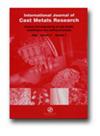不同冷却速率对硅强化球墨铸铁拉伸性能的微观组织影响评价
IF 1.1
4区 材料科学
Q3 METALLURGY & METALLURGICAL ENGINEERING
International Journal of Cast Metals Research
Pub Date : 2020-05-03
DOI:10.1080/13640461.2020.1757917
引用次数: 4
摘要
摘要采用两图程序评估了不同冷却速率下生产的不同硅强化球墨铸铁的微观结构对拉伸应变硬化的影响。在矩阵评估图中,不同球墨铸铁的数据通过线条进行识别。当Si为2.5 wt%时,最佳拟合线的截距为正,这与应变硬化的物理意义一致,但截距随着硅含量的增加和冷却速率的降低而降低,当Si为4.5 wt%和冷却速率缓慢时,截距出乎意料地变为负。发现负截距与石墨退化有关。在完整性评估图中,研究了微观结构对延展性的影响,报告称石墨退化显著降低了延展性。因此,首次提出的对不同化学成分和生产路线的球墨铸铁进行分类的两图程序,也可以表明球墨铸铁中存在石墨退化。本文章由计算机程序翻译,如有差异,请以英文原文为准。
Assessment of microstructure effects on tensile behaviour in silicon strengthened ductile irons produced through different cooling rates
ABSTRACT A two diagram procedure was used to assess the microstructure effects on tensile strain hardening in different silicon strengthened ductile irons produced through different cooling rates. In the Matrix Assessment Diagram, the data from different ductile irons were identified through lines. While with Si 2.5 wt-% the intercept of the best fitting line was positive in agreement with the physical meaning of strain hardening, the intercept decreased with increasing silicon content and decreasing cooling rate, becoming unexpectedly negative with Si 4.5 wt-% and slow cooling rates. The negative intercepts were found to be related to graphite degeneracy. In the Integrity Assessment Diagram the effect of microstructure on ductility was investigated, reporting that ductility was reduced significantly by graphite degeneracy. So the two diagram procedure that was first proposed to classify ductile irons with different chemical compositions and production routes, can also indicate the presence of graphite degeneracy in ductile irons.
求助全文
通过发布文献求助,成功后即可免费获取论文全文。
去求助
来源期刊
CiteScore
2.70
自引率
7.10%
发文量
14
审稿时长
7.5 months
期刊介绍:
The International Journal of Cast Metals Research is devoted to the dissemination of peer reviewed information on the science and engineering of cast metals, solidification and casting processes. Assured production of high integrity castings requires an integrated approach that optimises casting, mould and gating design; mould materials and binders; alloy composition and microstructure; metal melting, modification and handling; dimensional control; and finishing and post-treatment of the casting. The Journal reports advances in both the fundamental science and materials and production engineering contributing to the successful manufacture of fit for purpose castings.

 求助内容:
求助内容: 应助结果提醒方式:
应助结果提醒方式:


